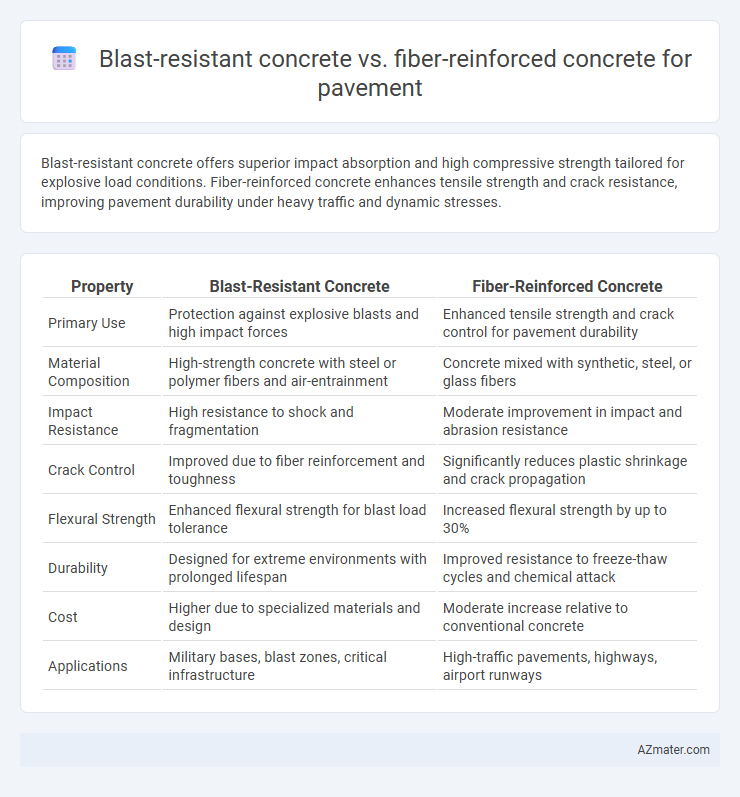Blast-resistant concrete offers superior impact absorption and high compressive strength tailored for explosive load conditions. Fiber-reinforced concrete enhances tensile strength and crack resistance, improving pavement durability under heavy traffic and dynamic stresses.
Table of Comparison
| Property | Blast-Resistant Concrete | Fiber-Reinforced Concrete |
|---|---|---|
| Primary Use | Protection against explosive blasts and high impact forces | Enhanced tensile strength and crack control for pavement durability |
| Material Composition | High-strength concrete with steel or polymer fibers and air-entrainment | Concrete mixed with synthetic, steel, or glass fibers |
| Impact Resistance | High resistance to shock and fragmentation | Moderate improvement in impact and abrasion resistance |
| Crack Control | Improved due to fiber reinforcement and toughness | Significantly reduces plastic shrinkage and crack propagation |
| Flexural Strength | Enhanced flexural strength for blast load tolerance | Increased flexural strength by up to 30% |
| Durability | Designed for extreme environments with prolonged lifespan | Improved resistance to freeze-thaw cycles and chemical attack |
| Cost | Higher due to specialized materials and design | Moderate increase relative to conventional concrete |
| Applications | Military bases, blast zones, critical infrastructure | High-traffic pavements, highways, airport runways |
Introduction to Advanced Pavement Concrete Technologies
Blast-resistant concrete for pavement incorporates high-strength aggregates and specialized admixtures to enhance impact durability and resistance to explosive forces, making it ideal for critical infrastructure and military applications. Fiber-reinforced concrete utilizes synthetic or steel fibers dispersed within the matrix to improve tensile strength, crack control, and fatigue resistance, offering increased longevity and performance under repetitive loading. Advanced pavement concrete technologies emphasize tailored material compositions to meet specific environmental and load-bearing demands, ensuring enhanced safety and durability in modern roadway construction.
Understanding Blast-Resistant Concrete
Blast-resistant concrete for pavement utilizes specialized mix designs incorporating high-strength aggregates and admixtures to enhance energy absorption and reduce spalling under explosive impacts. This concrete type often integrates steel fibers or composite materials to improve tensile strength and ductility, making it more capable of withstanding blast pressures compared to traditional fiber-reinforced concrete. Its application in critical infrastructure pavements ensures improved durability and safety by mitigating damage from shock waves and debris generated during explosions.
Overview of Fiber-Reinforced Concrete
Fiber-reinforced concrete (FRC) enhances pavement performance by integrating synthetic or steel fibers into the concrete matrix, significantly improving tensile strength, crack resistance, and durability under heavy traffic loads. Unlike blast-resistant concrete, which is specifically designed to withstand high-energy impacts and explosive forces, FRC primarily targets improved flexural toughness and fatigue resistance in pavement applications. The increased post-crack load capacity of fiber-reinforced concrete reduces maintenance costs and extends service life, making it an optimal choice for durable, resilient pavements.
Key Material Properties Comparison
Blast-resistant concrete exhibits superior compressive strength and enhanced energy absorption capacity compared to fiber-reinforced concrete, making it ideal for impact and explosive load scenarios. Fiber-reinforced concrete offers improved tensile strength, crack resistance, and ductility due to the distribution of synthetic or steel fibers within the matrix. Both materials provide durability advantages for pavement applications, but the choice depends on specific load conditions and environmental exposure requirements.
Performance Under Extreme Loads
Blast-resistant concrete exhibits superior performance under extreme loads by effectively absorbing and dissipating high-impact forces, minimizing structural damage and maintaining pavement integrity. Fiber-reinforced concrete enhances tensile strength and crack resistance, improving durability under dynamic stresses but may not withstand the sudden, intense pressures associated with blast events as effectively. Optimizing pavement design for extreme load scenarios often involves integrating blast-resistant materials to ensure resilience and long-term serviceability.
Durability and Lifespan Considerations
Blast-resistant concrete exhibits superior durability under extreme impact and explosive forces, making it ideal for high-risk pavement applications requiring enhanced protection. Fiber-reinforced concrete improves tensile strength and crack resistance, extending pavement lifespan by minimizing microcracking and mitigating deterioration from freeze-thaw cycles. Both materials enhance durability, but blast-resistant concrete prioritizes impact resilience, while fiber-reinforced concrete emphasizes long-term serviceability and structural integrity.
Cost Analysis and Economic Feasibility
Blast-resistant concrete typically incurs higher initial costs due to specialized materials and design requirements compared to fiber-reinforced concrete, which is more cost-effective for standard pavement applications. Fiber-reinforced concrete enhances durability and reduces maintenance expenses over the pavement's lifespan, improving overall economic feasibility. Evaluating long-term performance and repair frequency is essential to determine the most economically viable option for specific infrastructure projects.
Construction Methods and Practical Implementation
Blast-resistant concrete for pavement involves specialized mix designs incorporating high-strength aggregates and fiber reinforcements to enhance energy absorption during explosive events, requiring precise placement and curing techniques to ensure structural integrity. Fiber-reinforced concrete uses synthetic or steel fibers dispersed throughout the mix to improve tensile strength and crack resistance, enabling faster construction with standardized pouring and finishing processes suitable for large-scale pavement projects. Practical implementation of blast-resistant concrete demands stringent quality control and testing protocols, while fiber-reinforced concrete offers adaptability in various environmental conditions with reduced maintenance needs.
Environmental Impacts and Sustainability
Blast-resistant concrete incorporates energy-absorbing materials, improving durability but often relying on high-cement content, which increases CO2 emissions during production. Fiber-reinforced concrete enhances crack resistance and extends pavement lifespan while enabling the use of recycled fibers, reducing landfill waste and lowering environmental footprint. Selecting fiber-reinforced concrete supports sustainable pavement solutions through improved mechanical performance and diminished ecological impact compared to traditional blast-resistant mixtures.
Application Suitability and Recommendations
Blast-resistant concrete offers superior strength and durability against extreme impact loads, making it ideal for critical infrastructure such as military bases, airports, and high-security facilities where explosive threats are a concern. Fiber-reinforced concrete enhances tensile strength, crack resistance, and fatigue durability, proving more suitable for heavy-traffic pavements, highways, and urban roads requiring long-term performance under dynamic loads. For applications demanding high impact resistance and security, blast-resistant concrete is recommended, while fiber-reinforced concrete is preferred for general pavement projects emphasizing crack control and extended service life.

Infographic: Blast-resistant concrete vs Fiber-reinforced concrete for Pavement
 azmater.com
azmater.com